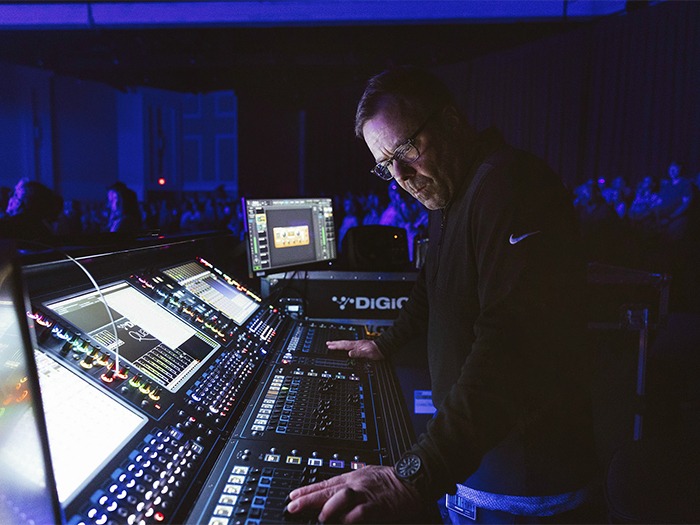Chris Tomlin recently returned to Nashville’s 20,000-seat Bridgestone Arena for his seventh annual Good Friday Nashville concert benefiting foster care and adoption crises through For Others, a non-profit foundation created by Tomlin and his wife, Lauren.
Since its inception in 2017, the event has become a record-setting evening, smashing attendance records as the largest ticketed Christian concert in the history of the venue. This year, on April 7, the Grammy Award and multiple Dove Award winning artist and his band were joined onstage by a number of special guests, including CeCe Winans, Blessing Offor, and Bethel Music’s Jenn Johnson, plus New York Times best-selling author/pastor Max Lucado, who shared a poignant message for the evening.
Good Friday Nashville fell near the middle of Tomlin’s latest musical trek, The Stories of Worship Tour, which began on February 23 in San Antonio, Texas and crossed the finish line 26 shows later on April 23 in Grand Rapids, Michigan. Aside from the artist’s songs and personal stories, what also characterised all of these shows was sound mixed through DiGiCo Quantum consoles, supplied by Spectrum Sound, with engineer Jeff Sandstrom manning a DiGiCo Quantum338 desk at front of house. Monitor mixing for the Good Friday event was handled by Joseph Mirakovits on a Quantum7, while for the tour, monitors were mixed on a second Quantum338 by Meredith Empie, a Belmont University audio engineering-technology graduate, who also served as the RF technician for the Bridgestone Arena show.
What was notable about the sound on this tour was that Tomlin was not carrying his own PA system, instead using the installed sound systems in the large church venues that the tour visited. It was a return to Tomlin’s roots, says Sandstrom, who has worked with the artist for 15 years.
“This was how we toured for years, before we transitioned to arenas, carrying our consoles and some subs and front-fills for the house PA systems,” he explained. “It’s so different being back in churches, where the sound systems and acoustics are different every show. It’s challenging but it can also be fun, and the Quantum338 helps that because it gives me a consistent yet flexible work surface for every show. I can load my file and just mix, with muscle memory letting me concentrate on whatever new wrinkles there might be in each venue. I’m totally comfortable on the console, so I can really focus on the PA and the house.”
The consoles were looped together on Optocore, with a single shared SD-Rack for inputs. Sandstrom says the workflow is simpler than for arena shows, with gain control at the monitor desk. “If there are any changes to the gain structures, we communicate that, but mostly it’s been a set-it-and-forget-it kind of workflow, which is great. You can really focus on the music while saving on truck space and load-in times.”
Like all DiGiCo users, Sandstrom is a fan of the console’s flexibility, being able to “put any fader anywhere,” he said. But specifically about the Quantum processing, he’s been using the Spice Rack on key input channels, including on Tomlin’s vocals and on the bass guitar, as well as the onboard Tube Drive on kick, snare, and bass. The Spice Rack’s sonic seasoning melds nicely with the Waves EQ and dynamics plug-ins he likes, which are integrated with the console via a Waves SuperRack system. “Some of that workflow comes from my studio days, when I relied on the consoles for mic-pre’s and EQ and outboard processors for dynamics,” he recalled. “That’s one of the key things about DiGiCo; I can work any way I want to, and the console conforms to my workflow, not the other way around.”
Empie has similar plaudits for the Quantum338 desk. “I can set it up the way that works best for my preferred workflow, keeping everything within easy reach; I can almost live on a single page for the whole show,” she says. “I know where every fader is without having to think about it, and that lets me concentrate on creating a great mix.”
She added that she hasn’t had to delve too deeply into the Quantum338’s processing, relying on a show file created by her predecessor and the console’s naturally great sound. However, the onboard reverbs and dynamics help in a very specific and critical manner on this tour. “Churches can be a challenge because each one can be very different from the next acoustically; one can sound as dry as a studio, while another has tons of slapback coming from the back wall,” she explains. “Either way, it can interfere with keeping the mix onstage as tight and transparent as Chris would want. Using a combination of reverb, gates, and compression, I can compensate for either of those scenarios. With the Quantum338, I’m pretty much ready for any environment we’re playing.”
That Tomlin can mount a major tour of church venues without carrying his own sound reflects a significant shift for a church-based show, which can now expect to encounter tour-level PA systems, such as L-Acoustics and d&b audiotechnik brands, installed in houses of worship. “There’s been a huge improvement in church sound in the last few years; they’ve become much more like modern music venues,” Sandstrom said. “With the Quantum consoles, we’re bringing tour-level mixers into touring-grade concert environments that just happen to be churches and the sound has never been better.”

